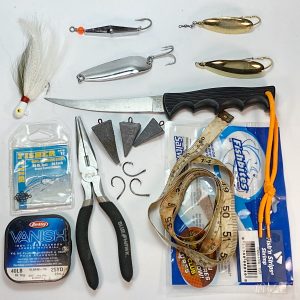*As an Amazon Associate I earn from qualifying purchases.
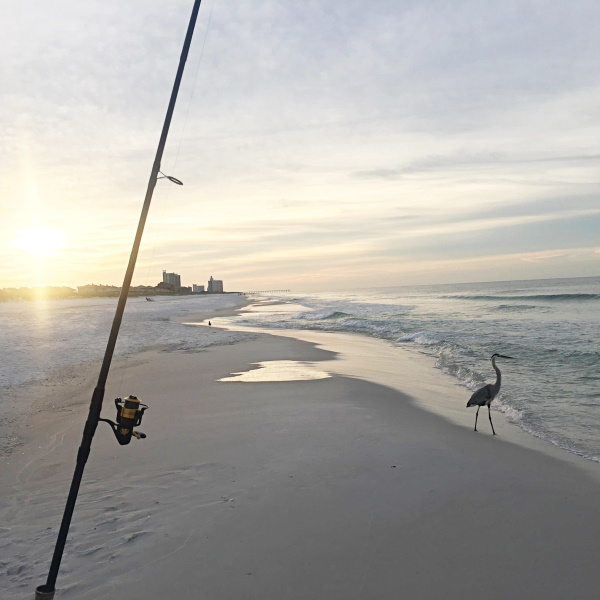
You ever been on a family beach vacation and noticed folks trying to catch fish along the waters edge? Maybe you didn’t see them having much luck. It might be logical to think they were wasting their time. Once upon a time, that’s what I thought. But, I can assure you, there is excellent surf fishing along the beach.
It’s well worth your time to pencil in a few hours to go surf fishing on a family beach vacation.
A little knowledge and preparation will go a long way in ensuring you have the best chance at success in potentially small windows of time. Let me show you how to get the most out of your fishing time on the family vacation.
Clickable Table Of Contents
- How To Prepare For Your Trip
- Surf Fishing Equipment
- Best Baits For The Beach
- Lures That Work In The Surf
- Where To Go
- What You Can Catch
- Reading The Surf
- Setting Up On The Beach
- Keeping Fish To Eat
- Some Final Tips
Preparation For Beach Fishing
Preparation is key to squeezing the most out of your limited fishing time. Besides accumulating proper gear, there are several other things you need to put some thought into ahead of your trip. You should check weather and fishing reports ahead of your trip, and decide on a plan of attack. Scrambling to figure all this stuff out after you arrive wastes valuable time with your family.
Preparation Considerations
- Check Weather And Fishing Reports
- Determine Beach Access Points
- Backup Plan
- License
Checking Weather And Fishing Reports
My wife is very understanding of my obsession, so hopefully yours is as well. Otherwise you might really need to compact your fishing window as much as possible. In that case, weather patterns will be all the more important to you.
Weather
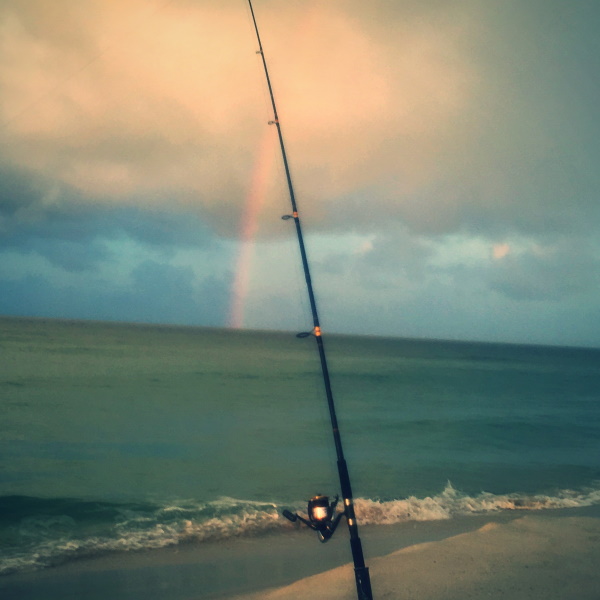
Your standard weather report is your first tool of planning. Extremely windy days, rough waves, or thunderstorms can all have an impact on what time slot(s) you choose. Take your favorite pick of online weather sources and plan your fishing according to the best weather days. If it’s going to be a 50% chance of storms later in the week, it’s best to concentrate your fishing on the front end, and vice versa.
Waves
Waves are another factor that can really mess up a day of fishing. Large crashing waves dirty up the water and make it hard to keep a bait on the bottom. A lot of times, bad weather days produce nothing but saltwater catfish.
You won’t find wave information in your standard weather reports, so you’ll have to dig a little deeper. For predicted wave action, search the web for “surf report” plus the name of the region you plan to fish. As an example “Surf report Pensacola Beach” will pull up several websites. Surf-forecast.com is one I have used, but there are others.
You’ll want to fish on days when it’s not projected to be as rough. Sometimes it’s very obvious that you should fish towards the beginning of your family trip as opposed to the end. Much like a standard weather reports, it’s best to work your fishing around projected wave activity.
Tides
Another weather factor that you can use to leverage the odds in your favor is tide movement. Generally, fishing around a moving tide is more productive than a slack tide.
If possible, schedule your outing around a tide change. With that said, morning time trumps tide movement for me, at least where I fish. Fishing seems to be better at sunrise, whether there is tide movement or not.
Fishing Reports
It’s good to check local fishing reports of the place you’ll be going. Again, Google is your friend here. You aren’t necessarily going to be checking if the fish are biting well. Rather, you want to figure out what species are running in the surf the week you are vacationing. Then, you can game plan around what you’ll likely encounter. For example, if Spanish mackerel are around, you’ll maybe want to keep a second rig ready to cast at them.
Local pier reports are usually great places to get the info you need for the beach. Fish being caught from ocean facing piers are what you’ll encounter in the surf.
Determine Beach Access Points
To be most effective in your limited beach fishing window, you’ll want to scout out any beach access points ahead of time. Don’t waste your vacation searching for places to fish. Google Earth is your friend as well as Google in general. Try to nail down several options ahead of time. More about this later.
Backup Plan
It’s best to have more than one option, because sometimes you don’t know what you’ll encounter until you have boots on the ground. Using Google Earth or otherwise old information can bite you. It’s entirely possible for a beach access point to be temporarily or even permanently closed down for whatever reason.
I made a mistake one year of planning to fish under a pass on my vacation like I did the year before. That was the only plan I had. When I arrived, I found out that the entire area was closed for construction.
You might also find that a particular stretch of beach is eaten up with saltwater catfish, or with grass in the water making it nearly impossible to have a productive time. Having a couple other options to try can save your trip.
There are countless other reasons that you should have a backup plan to your primary beach fishing spot.
License
Don’t forget to purchase a saltwater fishing license ahead of time. I’ve not been checked for one very often, especially on the beach, but I have been checked. To give you an idea of cost, a 7 day Florida non-resident saltwater license is $30 in 2020.
Beware, if you’d like to specifically target sharks in Florida, there is a separate no-cost permit involved which you must first obtain.
Surf Fishing Equipment

If you’re trying to keep cost down, you can likely use much of what you already have on hand. With the exception of weights (buy some pyramid sinkers), any fishing gear you already have will catch plenty of fish from the beach.
One thing to note is that if you use your freshwater gear on the beach, you will need to take extra precautions. Saltwater can be murder on freshwater gear. Additionally, the powdery sand along the Gulf Coast is very damaging as well. Sand will find its way into every crevice of both you and your gear. Let’s discuss some of the gear you will need.
Clickable Table Of Contents For Gear Listed Below
- Fishing Rods For Surf Fishing
- Fishing Reels For The Surf
- Surf Fishing Rigs
- Hooks
- Weights
- Swivels
- Fishing Line
- Leader Material
- Sand Spikes
- Other Gear
Best Fishing Rods For Surf Fishing
Choosing A Surf Rod
The two main things to consider for a surf fishing rod are, how far it can cast and whether it can cast the amount of weight you need.
Casting Distance
There are going to be times when you’ll want to cast further out to reach busting schools of fish, or to reach over a sandbar. To accomplish this, ideally you want a longer rod than what you’d normally use inshore. Having a rod over 8 feet is very helpful when fishing from the beach. 10-12 feet is even better. But, again, you can start with whatever you already own, as there are plenty fish to target right along with waters edge.
Casting Heavy Payloads
In addition to being able to cast far, your rod needs to be rated to handle potentially heavy payloads. Sometimes it can take quite a bit of weight to hold a bait down in the surf (2-6 ounces). You can still use a regular bass rod you may already have on hand, but you’ll need to take it easy when casting so you don’t break your rod. Long ago I would lob 3 or 4 ounces out with a 6.5 foot medium action bass rod. It sure felt like I might break the rod, but I never did.
I wrote an entire article on how to choose a surf rod. You can check that out here – How To Choose A Surf Rod.
Best Fishing Reels For The Beach

There are so many options when it comes to reels for surf fishing that it’s impossible to tell you what the best reel is. “Best” depends heavily on where exactly you are fishing, what rod you are using, and what exactly you are fishing for. I’ll just tell you my thoughts on the matter and hopefully that will help.
Saltwater Approved Reels
There’s a difference between a freshwater reel and a saltwater reel. Mostly it has to do with key parts being designed to withstand the corrosion that comes with saltwater. Nicer reels are typically sealed more tightly to keep saltwater out of the guts of the reel in the first place.
The enhanced manufacturing used to build saltwater approved reels comes at a cost of course. So, you can expect to pay a little more for a quality saltwater reel. But, it’s going to last a lot longer when fishing the surf, so it’s a no brainer to upgrade when you feel you can afford to do so.
Even with saltwater reels, it’s still very important to rinse them off after each outing
Spinning vs Casting
Style of reel is mostly a matter of personal preference, so use what you are most comfortable with. A spinning reel does eliminate the concern of backlashing which is more prevalent in windy conditions. And, it’s always windy at the beach. My current preference is spinning reels on the beach. Conventional reels do cast further in the right hands, so I have considered changing at some point.
Some Considerations When Choosing a Reel
For most people, surf fishing usually consists of 1 or more of 3 different goals. The three goals are 1. Just catch some fish, any fish. 2. Catch a big fish or 3. Catch a particular species of fish. For me personally, My primary goal is to catch good eating fish, such as pompano, whiting or redfish. I’ll take whatever is running the surf and be happy. Secondarily, I’m always trying to snag something big with a larger 2nd setup. Below I’ll try to break down some different reel sizes that will serve you well, depending on what you want to do.
Best Sized Fishing Reels For Beach Fishing
I’ll focus on spinning reels here, as I think they are best for the beach for most folks. But, a similar thought process can be applied to conventional reels.
Spinning reels are commonly broken down by size using a number system. The most common method of noting the size of a spinning reel is to use a number in the thousands – 1500, 2000, 4500, 5000, 7000, etc, with the lower numbers being smaller reels with lower line capacity. This classification system is unfortunately not standard across the industry.
Spinning Reel Sizes For The Surf
- Small Setup (2500 to 3500)
- Medium Setup (3500-5500)
- Large Setup (6000+)
Some manufactures may use different numbering schemes. For the sake of discussion we’ll use the most common classification – a number in the thousands. Daiwa, Penn, and Shimano, among others, all use this classification system on many of their reels.
| 2500-3500 (small) | 3500-5500 (medium) | 6000+ (large) |
|---|---|---|
| Pompano | Redfish | Bull Redfish |
| Whiting | Black Drum | Medium Sharks |
| Spanish Mackerel | Small Sharks | Tarpon |
| Small Bluefish | Snook | Jack Crevalle |
| Flounder | Stripers | King Mackerel |
Small Reels
(2500-3500)
Target species: Pompano, Whiting, redfish, bluefish, flounder, sheepshead, spanish mackerel, etc
2500 to 3500 size spinning reels with 12 to 20 pound mono are an excellent choice for surf fishing. It’s light enough that it won’t wear you out if you want to cast lures with it. A reel in this size can handle most fish in the surf such as whiting, pompano, and redfish. If something larger such as a big drum or stingray hits your bait, you may or may not be under manned. It just depends on how big the fish is and if he is content running down the beach. If a large fish is headed straight away from the beach, and it’s obvious that there is no way you can turn him around, it’s best to just go ahead and break him off before he spools you.
Medium Reels
(4000-5500)
This category of reel is going to be your best all around size for general surf fishing. A reel in this range is going to hold about xxx yards of 20 pound braid so you’ll have the line capacity to cast far and still have plenty of line to handle a fairly big fish. My favorite size for an all around surf fishing reel is a 4500.
Large Reels
(6000+)
Stepping up to a larger reel let’s you successfully target larger species such as bull reds, tarpon, jack crevalle, and sharks. I like 50 pound braid on my big rod for the extra strength and abrasion resistance. I have an older Shimano Spheros (18000) when they were actually good reels, and my friend has the largest Penn Spinfisher V (10000). These are a couple examples of reels that will handle very large fish in the surf. You don’t have to go that large though. We use those because we also target sharks with them. A 7000 sized reel is really good on the beach.
Great Reels For Surf Fishing
- Penn Spinfisher
- Penn Battle
- Penn Fierce
- Shimano Baitrunner
- Daiwa BG
There are also some cheaper quality options available from Okuma and Kastking. When it’s all said and done, a 4000-5000 sized reel from the list above will serve you well for all but the largest of fish.
2 Best Surf Fishing Rigs
The 2 main rigs I use on the beach are the pompano rig and the fish finder rig. While there are many variations of these 2 rigs and different ways to tie them, the concepts remain the same. With either option, 20-30 pound mono or fluorocarbon works well. Fluorocarbon will get your more bites in clear water.
To be clear, the pompano rig is not just for pompano. It’s a great all purpose rig that will catch most of what’s out there. A lot of surf fishing rigs are going to have too much terminal tackle tied into them, which scares off a lot of the visually-minded fish. That’s why I like pompano rigs. They can catch line shy fish, as well as most of the other stuff swimming in the surf.
Pompano Rig (High Low Rig)

A Pompano rig is typically a 2 or 3 hook dropper loop bottom rig with a bead and sometimes a float above each hook. You’ll attach your main line to one end by tying to the swivel. Then, you’ll add a pyramid sinker to the other end by using either a swivel or by looping it on.
I prefer to make my own pompano rigs with quality 1/0 circle hooks and orange beads. The orange beads mimic the bright orange egg sacs found underneath some female sand fleas.
Truth be told, you don’t need the floats and beads. You’ll do just fine with only hooks and bait. I guess in that case you’d call it a high low rig instead of a Pompano rig.
If you don’t care to learn how to tie your own rigs I’d suggest buying some at a tackle shop near the beach. A good tackle shop is going to have a great selection of beach fishing rigs. My preference for store bought rigs is the same as mentioned above – a 2 hook design with 1/0 circle hooks, with or without floats and orange beads.
I like 1/0 circle hooks on the rig better than the kahle hooks you’ll often see. The main thing is that you want something with as little hardware as possible. Ideally, it should have one small non-flashy swivel where your line attaches, and just loops where the hooks are attached – not extra swivels.
Fish finder rig, or Carolina rig
A fish finder rig is close cousins, or maybe even twins to the Carolina rig that’s so popular among bass fishermen. It’s extremely easy to tie and is ideal for surf fishing. The fish finder rig consists of a sliding sinker on your mainline, a swivel to keep the sinker on your line, and a length of leader with a single hook. It’s best to throw in a bead to protect your main line knot from getting beat up by the sinker.
Since the weight is sliding on the mainline, A fish finder rig encourages a fish to fully take the bait before feeling the weight of the sinker.
Attaching Your Weight
I prefer to use sinker slides as shown for attaching a sliding weight. But, you can also just use a regular swivel. Simply attach about a 3” loop of mono to your swivel, then loop it through the sinker to attach it to your mainline. With either setup, it’s each to change out weights to match the conditions.
Best Hooks For A Fish Finder Rig
I always use larger 5/0-9/0 circle hooks on the end of my fish finder rigs since I use it to target larger fish. But, you can use whatever you like.
Fish Finder Leader Section
Don’t make your leader too long or you’ll get a helicoptering effect that will shorten your cast drastically. I like 40-80 pound mono for my leader.
Baiting A Fish Finder Rig
Bait your fish finder rig with whatever bait you have. I usually use fresh cut bait I pull out of the surf. Ladyfish, pinfish, whiting and bluefish all make great cut bait.
If I come across a bait fish about the right size, I’ll put the whole live fish on the hook. Run your circle hook through a live fish just under the dorsal fin.
You can expect to have some cutoffs when fishing this way. Sharks will occasionally pick up hefty baits on a fish finder rig, and if you aren’t using wire, you’ll get cut off. Regardless, getting to see your rod double over before the line snaps will leave you with a story of the big one that got away. Maybe next year that will motivate you to step up to the more specialized sport of shark fishing.
Hooks
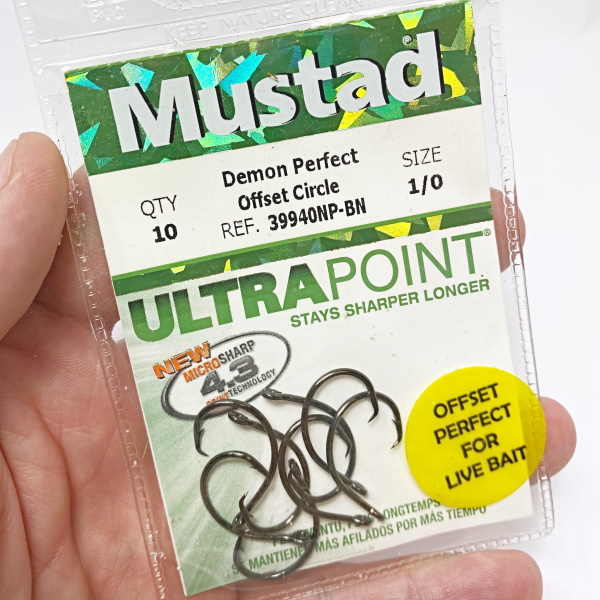
You don’t have to make hook selection complicated. One pack of quality 1/0 circle hooks is literally all you need. They will catch both small fish, and occasionally large fish.
If you plan to also specifically use larger baits to target larger fish, you’ll need to add a 2nd hook size. A 5/0 to 9/0 is a good hook size for larger fish. A large bait will choke a 1/0 hook too much. Your hook size should match your bait size.
Weights
You need a selection of pyramid weights between 1 ounce and 4 ounces. There are some places you may even need to go up to 6 ounces.
Depending heavily on where you’re fishing, sometimes the surf is calm enough to use a standard bank sinker. Bank sinkers will allow your bait to slowly move along the bottom, which can sometimes be extremely effective. I would say surf this calm would be a rarity on most beaches. Typically you’re going to be using 1 to 3 ounce pyramid sinkers instead.
Swivels
You can tie leaders on with uni to uni knots or FG knots, but it’s often easier to just use a swivel most of the time. When choosing swivels for surf fishing they need to be as dull as possible. A lot of fish in the surf will hit a shiny swivel, and cut your line. Matte black swivels are ideal. At the very least stay away from brass and silver colored swivels.
Fishing Line
Your main line can be either monofilament or braid. Each one has pros and cons. I generally use braided lines on the beach for increased casting distance and line capacity. But, monofilament is a great choice as well.
| Monofilament | Braid |
|---|---|
| Cheaper | Much more expensive |
| More abrasion resistant | Sandbars can be rough on braid |
| Shock resistant (stretchy) | Better sensitivity |
| Safer (likely won’t cut you) | Stronger |
| Might not need a leader | Leader is required |
| Less visible to fish | Increased line capacity |
| Forms a memory over time | Except for sandbar wear, it lasts longer with no memory |
Mono is cheaper and more abrasion resistant on the sandbars. Berkley Trilene Big Game is a great cheap mono line you’ll often see recommended for the salt. I’ve used it many times and it is a good product. There are many good mono lines on the market. Just take a look at Amazon reviews to narrow down your selection. I’ve used Stren, Berkley Big Game, Hi Seas and many others. There seems to always be some trendy fishing line coming on the market that people love, so it can seem like a moving target. But, you cannot go wrong with Berkley Trilene Big Game.
Braid is a lot more expensive than mono, but it does tend to last a lot longer, so that somewhat offsets the price difference.
10-30 pound mono, or 15-40 pound braid are good main line choices. The lighter test you go on the mainline, the more likely you’ll need to add a heavier bite leader or a shock leader. Shock leaders and bit leaders will be discussed below.
With a heavy enough monofilament main line you might not even have to use a leader. This is especially true if you are chasing pompono, redfish and whiting and there aren’t a lot of bluefish and other toothy fish around.
Leader Material
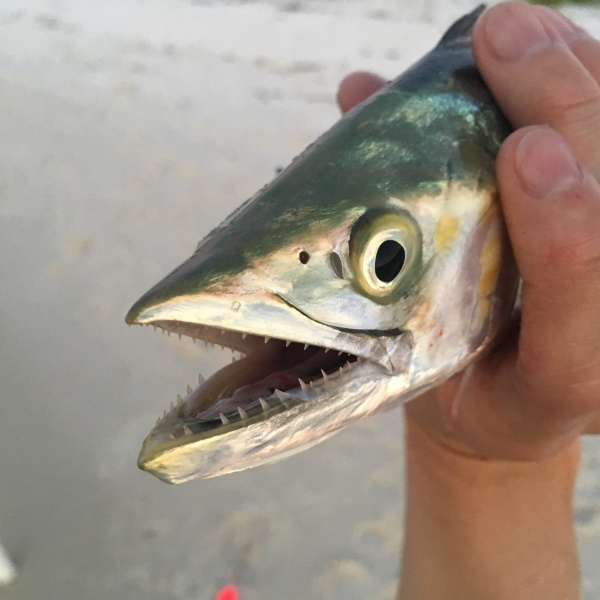
You’ll want to bring along some heavy monofilament or fluorocarbon leader material for several reasons, as discussed below.
Leader Uses
- Heavy test bite leaders prevent cutoffs from toothy fish
- Use a shock leader if your main line is undersized
- Use a section of clear line for line-shy fish
Bite Leader
A bite leader is a short, 12-36” section of heavier mono or flouro than your main line. It helps resist a bite through from toothy fish. Spanish mackerel, bluefish and ladyfish will all slice through lightweight monofilament. And, big ones can even slice through pretty heavy mono. 30-50 pound leader material will usually be good choices for a bite leader. For simplicity, you can use the same line for your shock leader.
Shock Leader
A shock leader is a section of monofilament tied to the end of your mainline in order to absorb the shock of casting heavy weight.
Shock leaders are sometimes necessary if you’re using a lightweight main line (10-15 lb) or a braided main line. With those two line options, an aggressive cast with heavy weight can snap your rig off during the cast and it’ll go flying into the ocean. A shock leader prevents this. To prevent your rig from snapping off, you can use 20+ pound mono as your main line, you can go easy on your casts, or you can use a shock leader.
A shock leader should be long enough to wrap 3-5 times around the spool during a cast.
Clear Leader For Line Shy Fish
If you use a braided mainline, you’ll want to have some clear leader material so that you can catch line shy fish in clear water situations.
Sand Spikes
There are several different styles of sand spikes for surf fishing, and each one comes in at a different price point. I’ll touch on some of the most common options below.
Sand Spike Options
- Homemade PVC
- Homemade Aluminum + PVC
- Store Bought PVC
- Ground Spike Rod Holders
- Solid Aluminum
Homemade PVC Sand Spikes
Homemade pvc surf spikes are generally made from a thicker pvc than the store bought ones. Because of this, they are much more durable, but that also means they are heavier which isn’t ideal when you are carrying them by hand.
Homemade spikes are going to be your cheapest option by far. Simply buy a 10 foot section of 1.5” sch40 pvc and cut it in half. Then, cut a sharp angle on one end, making sure to smooth out the rough edges where your rod sits. Doing this will give you 2 rod holders for about $6 total, or $3 each.
Here’s a tutorial I ran across that shows you how to make your own sand spikes – How To Make Your Own Sand Spikes.
Homemade Aluminum+PVC Sand Spike
An upgraded option over using just pvc is to use an aluminum stake in combination with a short section of pvc. The stake will anchor your spike, and the pvc will hold your rod. To make one, buy some 1 ½” aluminum angle about 50″ long, and attach a 1 foot section of pvc pipe to one end. The pipe can be attached using stainless bolts or hose clamps. Sand spikes made from aluminum are much more durable, and don’t require you to pound them into the sand.
Store bought PVC Sand Spikes
Store bought pvc spikes get a lot of hate because they are usually made from lightweight pvc. This causes them to bend or chip on the pointy end when driving them into hard sand or gravelly beaches. They are also usually fairly short. But, if you’re going to be fishing in soft sandy areas such as the Florida gulf coast and you understand that they won’t last forever, these are fine. You’ll actually appreciate the lightweight when you are carrying them across the sand. They run $6-$10 each.
Ground Spike Rod Holder
Ground spike rod holders consist of a section of plastic pipe mounted to the top of an aluminum stake. Because of the long narrow spike, these are supposedly a bit wobbly compared to other options. They cost about $20, so a pretty affordable option. They are also very lightweight. I have honestly not tried these yet, so I’m not sure how good they really are.
Solid Aluminum Surf Spikes

* Click image above to view prices on Amazon
Solid aluminum surf spikes are the highest quality option available. They are both lightweight and durable. Aluminum rod spikes are also the most expensive option. If you can find a Fish-N-Mate Surf Spike, like the one above, locally they are a great value. Otherwise, you can do like me, and just purchase them from Amazon. They will cost a little more, but it’ll be at your house in a few days. There are, of course, other brands that provide a similar design, but the Fish-N-Mate has been a round a while and has a great reputation.
I have noticed they sometimes go in and out of stock on Amazon, so you might have to check back later if they’re unavailable.
Other Gear
In addition to the things listed above, you’ll also want to bring along water to drink, snacks, sunscreen, shades, a knife, pliers, and other things like that. I have a more in depth list of things you’ll want to take to the beach here if you are interested – Surf Fishing Supply List
Bait
You certainly have lots of options when it comes to bait, and some of them will be regional. I really like fresh dead shrimp for the combination of convenience and effectiveness. As a backup to that, I always carry a pack of Fishbites as well. It would be hard for a beginner to go wrong with that combination. Let’s discuss surf baits in more detail below, then we’ll cover lures separately, in case you’re interested in going that route.
Best Baits For Surf Fishing
I’m approaching this article from a beginners standpoint, so we won’t cover things like cast netting for bait, or using a ghost shrimp pump. Below are some good baits that any new surf fisherman could get their hands on.
Quick Links To Each Bait Option
- Live Shrimp
- Fresh Dead Shrimp
- Squid
- Fishbites
- Live Fish
- Cut Bait
- Sand Fleas
- Frozen Shrimp
- Other Options
Live Shrimp
While it can be a challenge to transport live shrimp to the beach, and keep them alive, I think it’s worth the effort.
There is a saying “everything eats shrimp”, and it’s true. There is no telling what you might hook into when using live shrimp as bait.
I’ve transported live shrimp to the beach by toting a bucket with a battery powered aerator across the sand, but rolling it in a cart is much more tolerable. I’ve just about aged out of wanting to carry a bucket of live bait to the beach anymore. If you are young and in shape go for it!
There are several good ways to hook a live shrimp. Josh from SaltyScales.com has a great video on how to hook shrimp. I linked to that video below.
Once you buy live shrimp, it’s up to you to keep them alive. You definitely need a battery powered aerator to keep them lively. Besides that, you might also consider purchasing a 110AC aerator. A 110 aerator would allow you to buy live shrimp the day before and keep them alive overnight in your condo. This goes back to maximizing your fishing time on vacation. Having to deal with a bait shop run the morning of your fishing trip is a hassle, and requires you to wake up much earlier.
Fresh Dead Shrimp
While it’s hard to beat a live shrimp, a fresh dead shrimp is super effective as well. And, it can be more effective if you are targeting fish with small mouths. The key, though, is for it to be fresh. If it’s fresh enough for you to eat it, it’s fresh enough for fish to fight over it.
You don’t have to use the whole shrimp, especially if you’re targeting whiting, pompano and other such small fish. To use fresh dead shrimp, remove the head, and you can also peel it sometimes for better results. Thread half of the shrimp onto a small circle hook.
A good method for fishing with fresh dead shrimp is to put ½ of a shrimp on the hook followed up by a small piece of Fishbites. The Fishbites do several things for you. They add color, they help pin your shrimp onto the hook, and they provide a backup bait in case your shrimp gets bitten or slung off without you noticing.
Squid
One of the most common saltwater baits is squid. Boxes of frozen squid are typically readily available from any bait shop near the beach. For surf fishing, you’ll want to cut the body portion of the squid into fish-imitating strips, rather than chunking it up. Pinky sized pieces are about right. While squid doesn’t produce as well as shrimp, it’s far more durable, and stays on the hook longer. It’s also cheaper than shrimp
FishBites
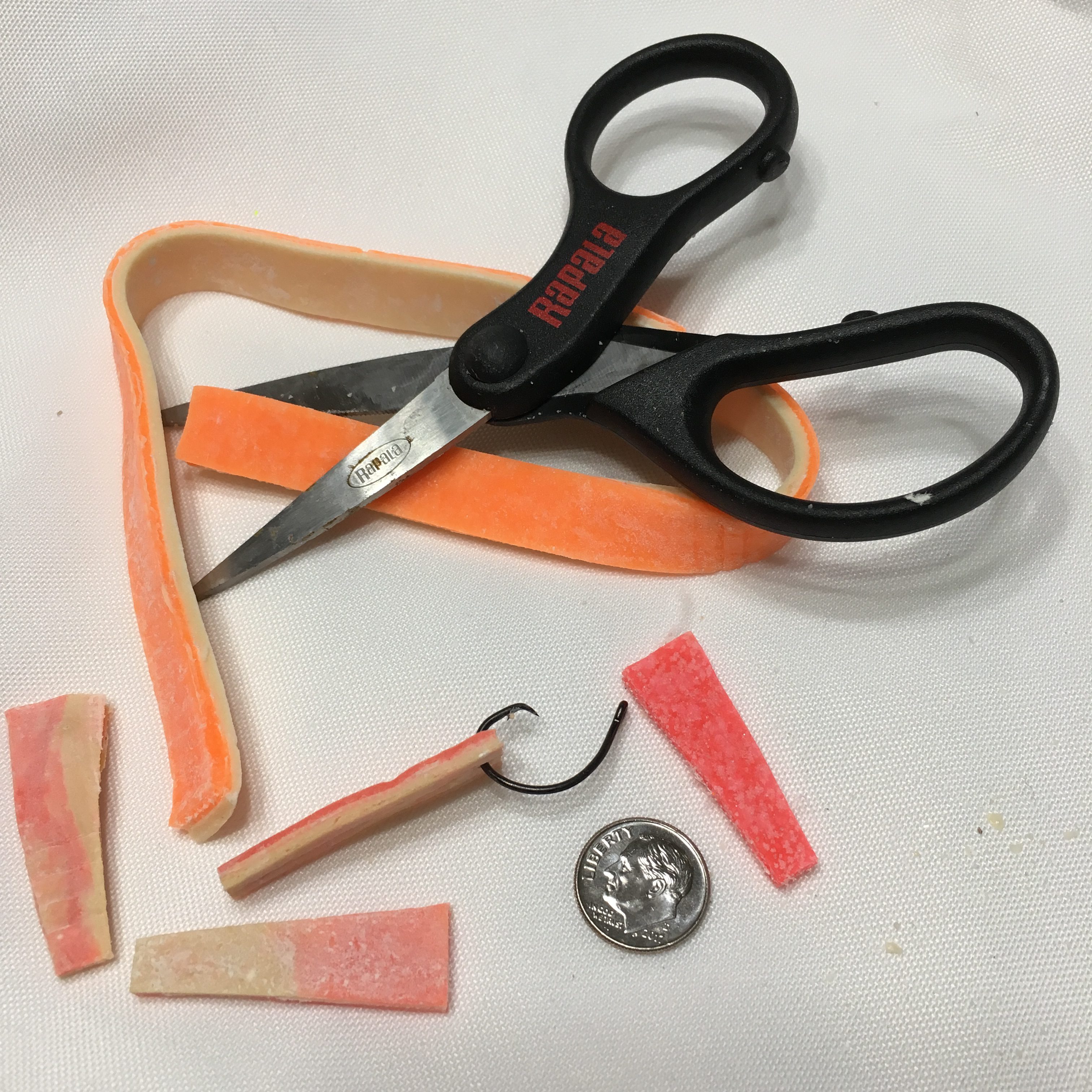
Fishbites are an artificial bait formed over a white mesh material. They are extremely durable, and the fish running the surf love them. I like the orange sand flea flavored ones as well as the pink shrimp flavored ones.
While there seems to be some competitors popping up here and there, I have only stuck with the Fishbites brand.
I have caught limits of pompano while just using Fishbites.
Benefits of Fishbites
- Serve as a quality backup bait that stores well
- Helps pin a bait, such as shrimp, to the hook
- Can serve as a secondary bait, in case your primary bait slings off
- Secondary bait in case your primary bait is eaten and you don’t notice
- Adds color to your primary bait
- Finally, they are a great standalone bait as well
Live Fish Or Minnows
Live fish make great bait for larger species. I like to put a 3-5” live fish on my big rod and toss it out to target bigger fish. I’ll let my big bait soak while I focus on bottom fishing for pompano. Trust me, you’ll know when something big picks it up. Hopefully you won’t have forgotten to loosen the drag on that rod, or you may be chasing it into the surf.
I don’t buy live fish from the bait store. Instead, you’ll often catch a small fish on your Pompano rigs that you can use for bait. You can specifically target small bait fish by downsizing your pompano rig with smaller hooks and baits. Or, you can use a sabiki rig to pull small fish out.
Cut Bait
An excellent option in the surf is to work your way up the food chain. A lot of fish are not regulated by size, so you can cut those up for fresh bait. If you catch something like a pinfish, Ladyfish, or legal sized bluefish, you can cut them up and throw them back out on a larger hook to catch things like bull redfish or sharks.
You can also obtain various species of frozen fish from the bait shop, such as mullet, and cut that up for an effective cut bait.
Vary the size of your cut bait to match the size fish you are targeting. I’ll use anywhere from a ½” square for small fish, to the size of half my fist or bigger for sharks and bull reds.
You can cut bait could be from frozen fish you got from the bait shop, or it could be something you caught in the surf. Mullet, blue fish, pinfish, and Ladyfish are some examples of good cut bait.
Sand Fleas
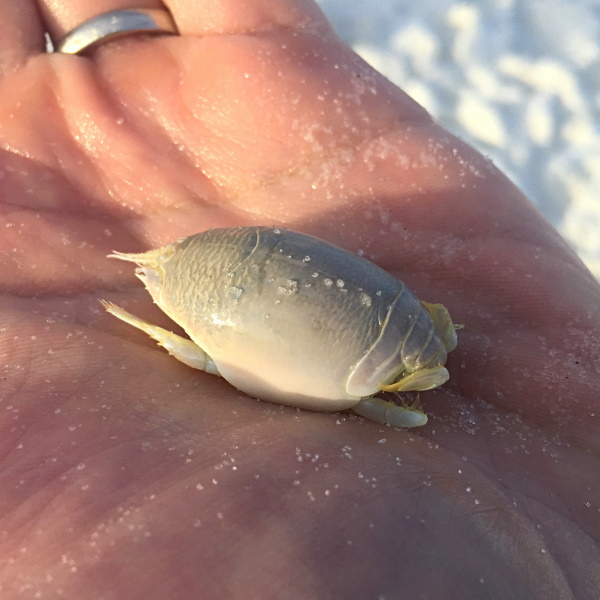
Mole crabs, aka “sand fleas”, aka sand crabs, are commonly referred to as pompano candy for a reason. They are a dynamite bait for pomp’s. But, much like shrimp, they catch all sorts of other fish too. This is one of the best free baits along the Florida gulf coast.
As a beginner you might find it difficult to locate and catch sand fleas. But, it’s actually quite easy if there are lots of them around. If you’d like to try them with a minimal investment you can buy a cheap metal colander and give it a go. Just know, without a sand flea rake, it’s going to be rough on your back unless you are a young sprite. Some people even catch them with their bare hands, but I never had much luck doing that. With a colander you can scoop up several at a time if they are around in numbers. Even if you don’t know how to spot them along the surf, blind scooping near where the water rolls up onto the sand is sometimes productive.
Frozen Shrimp
While frozen shrimp can work in a pinch, It’s my last resort. It’s not nearly as effective as fresh shrimp. Frozen shrimp also does not stay on the hook as well as fresh shrimp. It’s well worth the cost and effort to purchase FRESH dead shrimp from a bait shop or grocery store.
Other Options
There are a whole host of other things you could use such as clams, crabs and other miscellaneous options. Walk into any bait shop local to your destination and ask them what options they currently recommend for beach fishing.
Where To Get Bait
Bait Shop
The most obvious place to get bait is a local bait shop. This is where you’ll find the most options, and I would encourage you to make a run to a reputable bait shop near the beach you plan to fish. They are fascinating places to visit. Besides getting bait most effective for your area, you can often get advice on what bait is best for the time of year you are there. You’ll be able to get anything you need from a good local bait shop. Of course the downside is that you’ll usually pay more for many things. So, it’s generally better to obtain things such as terminal tackle, Fishbites and lures elsewhere. It is nice to support a local establishment so if your budget allows, spend your money at the local stores
Big Box Stores
You’ll find it’s often cheaper to buy some stuff from the chain stores such as Walmart or Academy. I generally buy my Fishbites from Walmart and get everything else from the bait shop. Walmart and other such stores near the beach carry all sorts of saltwater baits. You can also pick up a cheap sand flea rake here if you are feeling adventurous. Sand fleas are not hard to find if they are abundant where you will be fishing.
Grocery Store
If you arrive in town after the bait shops are closed, you still have the option of hitting up a local grocery store for fresh dead shrimp.
Gas Stations
As a last resort, you can usually find surf fishing bait in some beach side filling stations. The frozen shrimp found here will get you going. But, it’s not nearly as good as fresh dead.
Sabiki Some Bait From The Surf
Another option to get great bait after you get on the beach is to use a sabiki rig right in the surf. There is all sorts of small fish swimming out there that will hit a sabiki.
Two is One; One is None
When it comes to bait, I abide by the phrase which I guess originated in the military – “Two is one. One is None.” I never carry only one bait option to the beach. Typically I’ll take some fresh dead shrimp, a bag of Fishbites, and my sand flea rake. You could add in a sabiki rig for another option to pull some free bait out of the surf. No matter what baits you choose to go with, it’s always best to have at least 2 options.
Lures
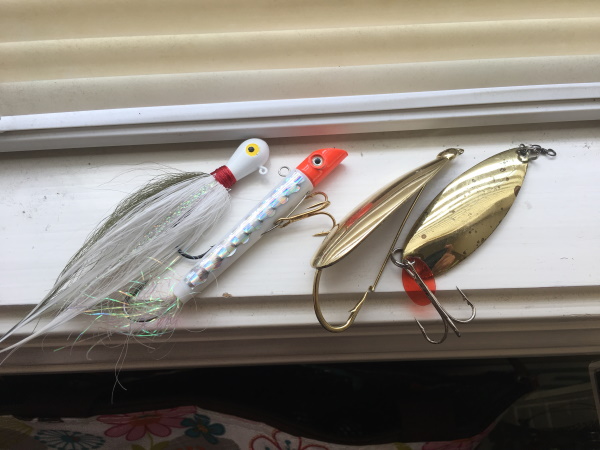
Listed below are some common lures for the surf. You’ll want to bring a handful of lures, and some of them need to be heavy.
Surf fishing is not like freshwater fishing in regards to lure loss. While it’s not uncommon to lose lures when bass fishing, it’s a whole other situation in the surf. It’s very common to run up on a day when lots of toothy fish are around. In those cases you can lose a lot of $8 lures in a hurry if you aren’t prepared. To guard against this, you should tie your lures on with a heavy mono leader. Even then, sometimes a thick leader will get bitten off, so bring some backup lures.
Good Lures For The Surf
- Gotcha Plugs
- Spoons – Kastmaster, Johnson Silver Minnow, Krocodile, Hopkins
- Bucktail Jigs
- Bubble Rig (for Spanish Mackerel)
- Topwater Plugs
- Berkley Gulp
- MirroLure
- Soft Plastic Fish Imitators
It is loads of fun to cast at passing schools of fish making their way down the beach. These could be spanish, bluefish, redfish, ladyfish, among others.
Sometimes I like to keep a rod on dedicated standby for those times a school comes into reach. Even if I don’t have a dedicated rod rigged up, I’ll keep some lures pre-tied to heavy leader material with a small non-flashy swivel on the other end. That way, if an interesting school comes by, I can cut my main line and tie that swivel on very quickly. That gets me in the game, with a lure I can launch a long ways.
Where To Go Surf Fishing
Unfortunately, exactly where to fish, is going to require a little bit of localized research. But, I’ll do my best to guide you in the right direction.
Public Beach Access Points

Many public beach access points will be very obvious from google earth. Large parking lots, gazebos and boardwalks give them away. Other access points might be subtle footpaths between two condos with just a handful of parking spots near the street. You can find promising areas using satellite view, then zoom into street view to look for beach access signs for confirmation.
You’re better off identifying a few access points ahead of your trip. But, you should also pay careful attention when driving in, as you might spot even more options closer to your condo or hotel.
Federal Parks
I’m most familiar with the Gulf Coast region. Down here, there is a chain of national parks called the Gulf Islands National Seashore. That group of parks provides excellent surf fishing opportunities. My personal favorite is the Fort Pickens Area in Pensacola Beach. Perhaps there are similar options near your travel destination. If so, it’s definitely worth checking those out. These are great places to get away from crowded beaches in order to have a more peaceful fishing trip.
Drive On To The Beach
Unfortunately I don’t have experience with drive on beach access, as the places I surf fish don’t allow it. I see folks online doing so in Texas and along the East coast, and it sure looks fun. I know a 4wd combined with lower air pressure in your tires is preferred. But, I won’t pretend to have much useful advice to give for vehicle beach access.
Fish Behind Your Condo
There are positives and negatives to fishing right outside your condo. It’s super convenient to be able to wake up and walk right out onto the beach without involving a vehicle. This is especially convenient when vacationing with family. It’s also nice to be able to have a few drinks while fishing and not have to worry about transportation back to the condo.
The downside to fishing outside a condo is the foot traffic on the beach, even early in the morning. During tourist season those condos can be packed. So, you’ll get maybe an hour or two of fishing peace before tourists hit the beach for morning walks. This isn’t quite as bad if you’ve booked a condo at the end of the line with undeveloped beachfront beyond you. But, if you’re in a huge line of condos, expect to get swarmed with tourists a short while after sunrise.
Beaches Of Passes
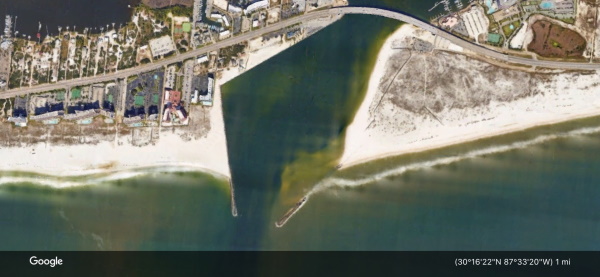
While not technically surf fishing, the sandy shores of passes are often excellent places to fish. I often use this as my backup plan if for some reason the beach is too rough, grassy or generally unproductive. Perdido Pass, in Florida, is a great example of such a place.
When To Go Fishing
Besides checking weather and tides to improve your odds, the absolute best way to ensure a successful outing is to go during a good time of year, and to go during low light periods. Exact time of year will vary depending on what region you fish.
Sunrise and sunset are typically far more productive fishing times for me on the beach. This is a mistake I have seen many tourists make. They don’t even start fishing until the sun is high overhead, and then they get frustrated and wonder why they don’t catch anything.
Time of year plays a significant role as well. Spring and fall are typically best for me, followed by summer, and then Winter. Typically there will always be something out there that you can fish for, no matter when you go. I really love spring and early summer along the Florida panhandle.
Fish You Can Catch On Vacation
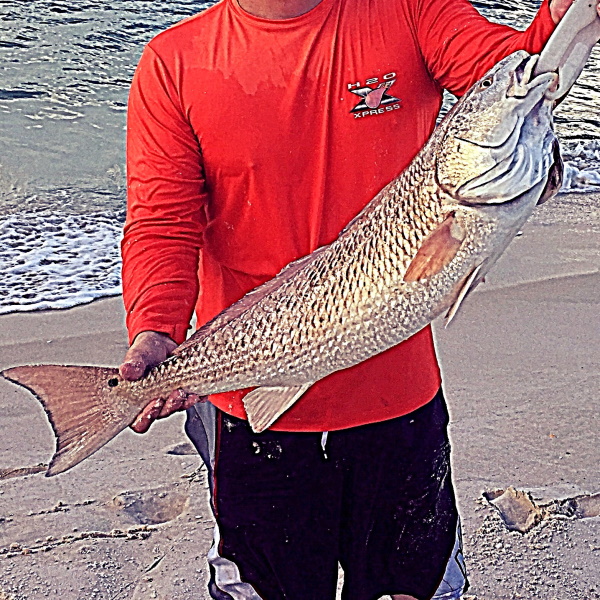
If you’re new to surf fishing, you might be surprised what you can pull out of the water right off the beach. Common catches will vary depending where you are.
Along the Florida panhandle you can expect pompano, whiting, redfish, black drum, bluefish, croaker, sharks, flounder, Spanish mackerel and others. You can also expect to hook into a whole host of “trash fish” such as catfish, stingrays, ladyfish and others.
Occasionally you’ll land things that are uncommon to your area. That’s part of the excitement of surf fishing, and saltwater fishing in general. You never quite know what you might catch when you throw a bait in the ocean.
Reading The Surf
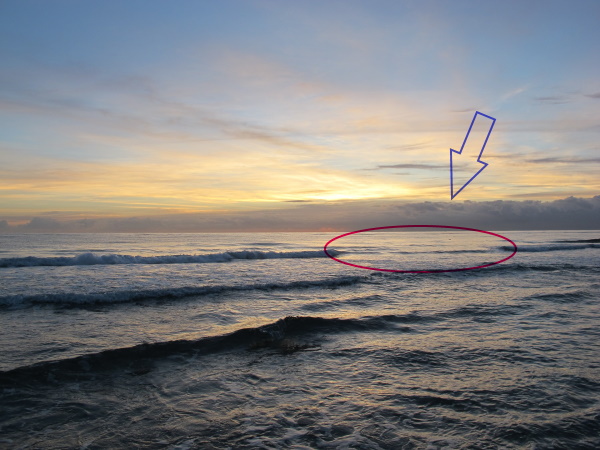
Before you bother setting up your equipment on the beach, you need to take a bit of time to watch the waves. The way the waves break along the beach will give you clues to the better fishing spots. Ideally you should check the beaches the afternoon before you fish so that you don’t waste precious time the next morning. But, that’s not entirely necessary.
The mistake most new beach fishermen make is to set up in a random spot along the beach. While that can work, it’s much better to try the “better looking” spots first.
Cuts, troughs, and holes are all great potential fishing spots on the beach.
Troughs
Troughs are the areas between the sandbars. The first gut, or trough, off the beach is a great area to fish. This could literally be 6 feet off the beach. Especially in low light conditions, all sorts of fish cruise this highway. As the sun gets high, and light penetrates the water, you might need to cast into the 2nd trough off the beach in order to get into the action.
Cuts
Cuts are breaks in a sandbar – this is where you find riptides. Fish concentrate here to navigate between sandbars and to feed on baits getting swept out by the current.
Holes
Holes are depressions in the bottom that are deeper than surrounding areas.
How To Read The Beach
It’s difficult to describe in words how to read the surf, so I attached a great YouTube video by Phil Hollandsworth. There are other more in-depth videos out there by Rich Troxler, but I find Phil’s video much shorter and right to the point.
If you can’t seem to identify anything “different” on the beach, don’t worry. You can usually find fish in the first gut (trough) right off the beach. If you can cast past the first sandbar into the 2nd trough, that is also an excellent area to fish. Just don’t keep your bait on top of a sandbar, as you won’t typically have much luck there.
If necessary, you can wade out some to get that extra bit of distance to get your bait into the 2nd trough. I’ll be honest I do this often, and I’m concerned every time I do it. Bull sharks and stingrays always seem to creep into my mind.
Setting Up And Closing The Deal
Once you’ve read the surf, and decided on your fishing spot, it’s time to make your way to the water’s edge. If you’re traveling light, and are planning to be mobile, then setup isn’t any big deal. However, if like me, you plan to use a stationary setup with multiple sand spikes, there is a little bit of a process.
Fishing Mobility
There’s a lot to be said for just keeping things simple. Quite frankly, I struggle doing this. I really like to get set up and settle in. However, it can be very effective to travel light so you can move down the beach until you find productive water.
A single rod and small collection of lures, or a cup of dead shrimp, can be a lot of fun when the fish are around and biting good. You can carry your stuff in a backpack or 5 gallon bucket.
But, as you’ve certainly figured out by now, most of this article is geared towards a stationary setup, as discussed below.
Stationary Surf Fishing
My favorite style of fishing on the beach is a stationary setup. That’s not to say I won’t abandon my setup to chase a school of busting fish, or diving birds, down the beach. That actually happens quite often. But, I like to create a home base of sorts first. Below are the steps that I follow when I arrive at the beach.
Setting Up For Stationary Fishing
- Install sand spikes
- Ready the poles
- Cast out rigs
- Set the drag
- Watch your rod tips
- Set the hook
- Beach the fish
- Reserve some energy for your family
Sand spike installation
The very first thing you should do is set up your sand spikes right where the water meets the sand. For pvc spikes, it’s helpful to carry a rubber mallet to tamp them firmly into the sand. If you don’t have a rubber mallet, wiggling and twisting will usually get them in far enough, as long as you remember to loosen your drag. You shouldn’t need a mallet if you brought aluminum spikes.
Ready your poles one at a time
If using more than one rod, I prefer to get them ready one at a time. If the fishing is on fire you may not even be able to handle a 2nd rod anyway. So, cast one rod out, and watch it while you get the 2nd rod ready.
Casting out your rig
To keep your reel out of the sand, place your rod in a sand spike while you get it ready. Attach your pyramid sinker, or other weight, to your surf rig. Then, bait up with your favorite surf bait.
If fishing early in the morning, start by casting into the first trough right off the beach. Over time, cast to different areas until you identify where the fish are relating that morning.
Sometimes you’ll get hammered by tiny fish up close to the beach. If so, you might want to try water a little further out to get away from them. But, I’ve seen all sorts of desirable fish up very close to the beach in the morning, so that’s where you should start your search.
Setting your drag
It is imperative that you loosen your drag when your rod is sitting in a surf spike. Bad things happen if you don’t. When setting your drag, you should be able to easily pull drag off the reel. A good way to gauge whether you have your drag set properly is to cast out and then reel up until you have a slight bend in the rod tip. You want your drag as loose as possible, but still tight enough to maintain that constant bend in the rod tip.
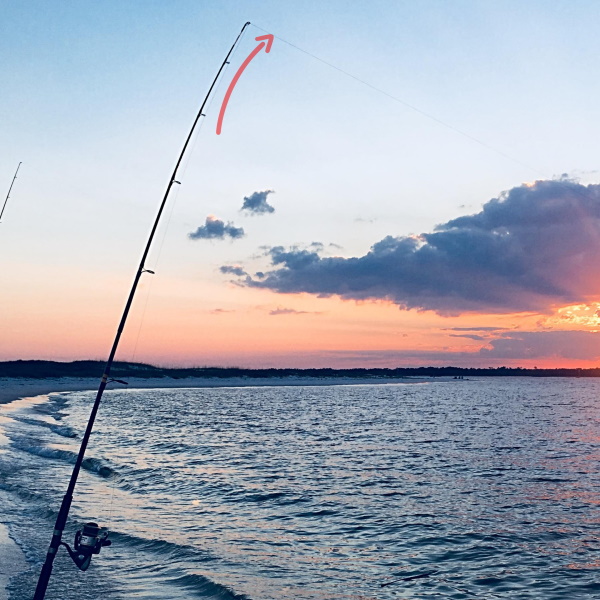
If your drag is too tight your rod and reel could get yanked into the surf. Your line could also break if a big fish hits it. Also, because of the pressure on your line, you might not be able to get the rod out of the rod holder in time before the fish gets away.
If a big fish hits your line just let him run with it for a bit before tightening your drag. That’s the beauty of circle hooks. You can give a fish time to eat a bait without as much fear of gut hooking the fish. A lot of times a fish will drop a bait. If so, give him a minute as he might pick it back up.
Watching your rod tips
While some reels have a clicker that you listen for, most stationary surf fishing is really about watching your rod tips. If the rod tip starts bouncing beyond the normal reaction to wave action then you have a bite.
You’ll also want to keep an eye on your line. If the line goes slack, you also likely have a bite.
It can be tricky at first to detect bites, as your rod tip will constantly bounce with the waves. But, your eyes will adjust and quickly accommodate for the rod movement caused by the surf.
Setting the hook
I always surf fish with circle hooks, so there really isn’t a true hook set in the normal sense. Instead, when you detect a bite, you need to tighten the drag down and then put pressure on the line. The hook should set itself in the corner of the fish’s mouth.
Beaching a fish
A fish of any decent size can put stress on both your rod tip and line when they get into the surf zone. They’ll use the crashing waves to their advantage in a fight. Rather than horsing a fish through the waves and risk breaking your line, use the waves to your advantage. Time a wave so that it helps you surf the fish onto the beach. Then simply hold him there until the wave recedes. Then you can retrieve your catch.
| Tip |
|---|
| Don’t turn your back on your beached fish if there are birds around. They will move in quickly to steal your fish when you are not looking. The last thing you want to deal with is a hooked bird. |
Pace Yourself
I generally find that the good fishing starts to taper off as the sun gets up good. Therefore, when I’m surf fishing on a family vacation, I wrap up my day by about 9am and head back to see the kids. It’s typically wise to pace yourself so as to reserve energy for family outings. Besides, it’s a much more effective use of your time to hit the beach two mornings for 2 or 3 hours each than one large block of time.
Evenings are the better time to include the kids in a little beach fishing if you’d like to do that. I can’t speak for your family, but there is no way I can get my kids out of bed and on the beach by 6am, so I don’t even try.
Keeping Fish To Eat
If you want to some keep fish to eat, you’ll ideally need to bring a cooler and ice to the beach with you. Without a surf cart this can be a real pain. But I’ve done it many times. A small cooler with a little crushed ice and a couple frozen 1 liter ice bottles seems to work best for me. This works well for smaller fish such as whiting, pompano, Spanish mackerel, and other similar sized fish.
If you think there’s a chance you’ll keep something large, you’ll want to have a large cooler in your vehicle with some ice. You’re going to have to stop what you’re doing and carry a large fish back to your car to offload it into a larger cooler. For this reason, I don’t ever plan to keep large fish from the surf unless I have a surf cart and large cooler with me.
Good Eating Fish
- Pompano
- Whiting
- Redfish
- Spanish Mackerel
- Flounder
- Small Black Drum
- Spotted Seatrout
- Croaker
- Bluefish (when prepared correctly)
- Mullet
- Sheepshead
- King Mackerel
Cooking Fish On Vacation
My family likes to stay in a condo with a kitchen when we go on family beach vacations. So, I have the option of cooking my catch on vacation, and I have done so several times. If you intend to cook your catch in a condo, you’ll obviously need supplies. Most things you can pick up at the local grocery store, so there is no need to pack everything. You’ll want a cutting board, a filet knife, Ziplock bags, fish fry batter, seasonings, and cooking oil.
Freezing Fish To Take Home

If you have access to a freezer, you’ll be able to freeze your catch for later. If not, you can always purchase dry ice locally to freeze your fish inside a cooler. Then, you can easily transport it safely for quite a distance. If you plan to transport it very far then dry ice is your answer.
Dispose Of Fish Parts
Don’t forget to get fish parts out of your condo ASAP. If you forget and leave cleaned fish in your condo while you leave for the day, you’ll have an unwelcome surprise waiting when you get back.
After you’re done eating, double bag your fish in trash bags and get it outta there!
Other Tips For Beginner Surf Fishermen
Below are some other random tips I feel a beginning surf fisherman needs to know.
SAND And Reels Don’t Mix
Make it a habit to place your rod back in a sand spike, or on a chair when you’re unhooking fish. The Gulf Coast, in particular, has some of the finest white powder sand I’ve seen anywhere. That stuff will quickly work itself into any open crevice imaginable. Keep your reels far away from it at all times if you want it to last.
Rinse Your Equipment
It is critical that you don’t forget to rinse your gear with freshwater after a day of fishing.
Saltwater is very corrosion if left to dry on your equipment. Even saltwater approved equipment should be rinsed off.
Sometimes beach access points provide a freshwater rinse station. If not, you can tighten your drag down and run them through a quick shower in the condo. Don’t forget to loosen your drag back up immediately afterwards. Don’t forget to rinse your rods eyes as well.
Reviving A Fish
If you’re used to a freshwater fishing environment, it could surprise you how powerful some of these fish are. Try your best to move quickly to remove the hook and get a photo. But don’t keep them out of the water too long. If a large fish is exhausted from a long battle you may need to get into the water with it to help revive it.
Cutting The Leader
If you feel like it’s taking too long to remove the hook, or the situation feels dangerous just cut your leader close to the hook and release the fish. The hook should rust out quickly in saltwater. This is probably your best recourse if you have a shark of any size or a stingray.
Fishing Rags
A rag is something that’s easy to forget but it weighs nothing so it’s a must have. Fish are slimy. Let’s be honest at some point you’ll want to access your phone while you are out there. Without something to wipe your hands on your gear is going to get pretty nasty.
Fish Grips
Fish lip grippers are fairly cheap, and they are nice to have in case you catch something you want to control for a pic. The plastic ones are saltwater resistant and float. You can pick a pair up for about $15.
Taking Photos Of Fish
Nothing is more frustrating than catching a really nice fish and having to dig for a camera while the fish is flopping on the sand. Keep a rag available to wipe your hands off and your phone where it’s readily available. There are usually plenty of other tourists or fishermen where I go that are more than willing to snap a photo for you.
Tourist Rigs

You’ll generally want to stay away from what I refer to as “tourist rigs”. These overbuilt rigs are commonly found in places like Walmart.
You’ll be able to spot them by the overbuilt nature of them. These things have lots of extra wire, extra swivels, oversized hooks, and too much hardware in general. Such a big flashy rig is going to spook a lot of fish.
Conclusion
It’s well worth your time to carve out a few hours from your family trip in order to do a little beach fishing. I’ve had some days on the beach that far surpassed some of the deep sea fishing charters I paid hundreds of dollars to go on.
Being able to marry 2 beloved pastimes together such as beach going and fishing is really something special. Add in the fact that you can do this on a family vacation, and I don’t see why more people don’t take advantage.
See you out there
Augustus Clay


